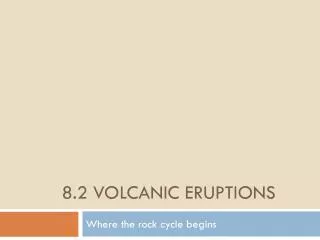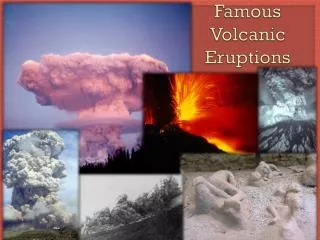
Volcanic Eruptions. Chapter 9 Section 1. Volcanic Eruptions. Volcanoes – areas of Earth’s surface through which magma and volcanic gases pass In seconds a volcanic eruption can turn an entire mountain into a cloud of ash and rock Helps form fertile farmland

nancy + Follow
Download PresentationAn Image/Link below is provided (as is) to download presentation Download Policy: Content on the Website is provided to you AS IS for your information and personal use and may not be sold / licensed / shared on other websites without getting consent from its author. Content is provided to you AS IS for your information and personal use only. Download presentation by click this link. While downloading, if for some reason you are not able to download a presentation, the publisher may have deleted the file from their server. During download, if you can't get a presentation, the file might be deleted by the publisher.

Volcanic Eruptions. Pgs. 148 - 152. Eruptions. How big can an eruption be? 10,000 times as big as an atomic bomb. Where do eruptions come from? Volcanoes Volcano – mountain that forms when molten rock called magma is forced to the Earth’s surface.
377 views • 10 slides

Section 6.1 Volcanic eruptions. 6.1 - Volcanic Eruptions. Volcanoes Areas of Earth’s surface through which magma & volcanic gas passes Creative Forces forming fertile farmland & large mountains Destructive Forces Turning mountains into clouds of ash & rock, destroying forests & homes.
423 views • 14 slides

8.2 Volcanic Eruptions. Where the rock cycle begins. Learning Targets. Compare the types of volcanic eruptions Describe a method for predicting volcanic eruptions. Volcanic Eruption. Magma collects in magma chamber Hot magma expands creates pressure
739 views • 32 slides

Famous Volcanic Eruptions. Volcanic Explosivity Index. The violence and size of a volcano’s eruption is expressed by the Volcanic Explosivity Index (VEI) . Values for the VEI range from 0 to 8, and are based on : the volume of material (lava and particles) erupted
617 views • 11 slides

TYPES OF VOLCANIC ERUPTIONS. By Jordan Schloer. The Types of eruptions. Hawaiian *Subglacial Strombolian *Phreatic Vulcanian * Lava Dome Peléan Plinian Surtseyan Submarine. Lava Dome .
2.86k views • 24 slides

Effects of Volcanic Eruptions. Volcanic Eruptions and Climate Change. Volcanic ash and gases spread throughout the atmosphere, they can block enough sunlight to cause global temperatures to drop. Can cause average global temperatures to drop by as much as 0.5 degrees Celsius.
323 views • 9 slides

VOLCANIC ERUPTIONS. A bit about volcanoes…. Volcanoes form when magma reaches the Earth's surface, causing eruptions of lava and ash. They occur at destructive (compressional) and constructive (tensional) plate boundaries. There are three different types of eruptions.
1.29k views • 11 slides

Volcanic Eruptions. Chapter 9 Section 1. Volcanic Eruptions. During an eruption magma is forced to the Earth’s surface Magma – molten rock below the Earth’s surface Lava – magma that flows on the Earth’s surface. Nonexplosive Eruptions. Most common type of eruptions
450 views • 19 slides

Volcanic Eruptions. Eyjafjallajökull. Information. It is located in Iceland It area is 100 km 2 This volcano erupted on 17 April 2010 When it erupted in 2010 it caused delays for aeroplanes to fly because of the ash. Map. Diagram. News Article. Volcano erupts in south Iceland
256 views • 6 slides

Volcanic Eruptions. MEDC Case Study - Mount St.Helens , USA. Mount St. Helens, USA – MEDC Case Study. Is part of the ring of fire. Well known for ash explosions and pyroclastic flows. Most famous eruption – 18 th May 1980. 57 people were killed, 250 homes destroyed.
434 views • 16 slides

Volcanic Eruptions and Structures. Extrusive structures Intrusive structures. Global Pattern of Volcanoes. Prior to the acceptance of the theory of Plate Tectonics geologists were aware of the location of volcanoes around the rim of the Pacific Ocean and called it the “Ring of Fire”.
693 views • 47 slides

Volcanic Eruptions. Fifth Grade WebQuest. Introduction Task Process Evaluation Conclusion Teacher page. Introduction.
739 views • 11 slides

Volcanic Eruptions. Fifth Grade. Introduction Task Process Evaluation Conclusion Teacher page. Introduction.
623 views • 10 slides

Volcanic Eruptions. By Jacob, Zach and Fletcher. Volcanoes come in three different shapes and sizes - cones, fields and calderas. A volcano is made by pressure under the earth Some volcanoes are explosive. Others can erupt in flows. What is a volcano ?. how to prepare for a Volcano.
244 views • 5 slides

Volcanic Eruptions Notes. By: Mrs. Hudson. Objectives:. Distinguish between non-explosive and explosive volcanic eruptions. Identify the features of a volcano. Explain how the composition of magma affects the type of volcanic eruption that will occur.
523 views • 24 slides

What Controls Volcanic Eruptions?. Ch 12.2. Some eruptions are quiet…. Kilauea, Hawaii. Some eruptions are EXPLOSIVE!. Mt. Pinatubo. Montserrat. Mt. St. Helens. What Controls Volcanic Eruptions?. How much water vapor (a gas) and other gases are trapped in the erupting magma
972 views • 42 slides

Volcanic eruptions. Volcanoes. Volcanoes Areas of Earth’s surface through which magma & volcanic gas passes Creative Forces forming fertile farmland & large mountains Destructive Forces Turning mountains into clouds of ash & rock, destroying forests & homes.
369 views • 14 slides

Volcanic Eruptions and Hazards. What is a volcano?. vent. A volcano is a vent or 'chimney' that connects molten rock (magma) from within the Earth ’ s crust to the Earth's surface. The volcano includes the surrounding cone of erupted material. cone. conduit. magma chamber.
961 views • 50 slides

Volcanic Eruptions and Hazards. What is a volcano?. vent. A volcano is a vent or 'chimney' that connects molten rock (magma) from within the Earth ’ s crust to the Earth's surface. The volcano includes the surrounding cone of erupted material. cone. conduit. magma chamber.
551 views • 50 slides

Section 1 Volcanic Eruptions. Chapter F6. Bellringer. Make a labeled drawing showing what happens when a volcano erupts. Then describe the photographs on pages 156 and 157 in your textbook. Why do the characteristics of volcanic eruptions vary?
350 views • 31 slides

Effects of Volcanic Eruptions. Key Concept: The affects of volcanic eruptions can change human and wildlife habitat. Volcanic explosions can have local and global effects. In April 1815, Tambora volcano in Indonesia erupted explosively.
232 views • 18 slides

Volcanic Eruptions. What is a volcano? A volcano is a vent or 'chimney' that connects molten rock (magma) from within the Earth’s crust to the Earth's surface. The volcano includes the surrounding cone of erupted material. How and why do volcanoes erupt?
169 views • 8 slides